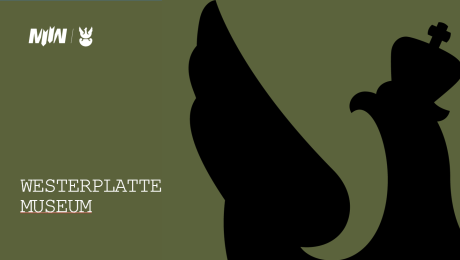Stage III and IV
Time: June 5th, 2018 - May 31st, 2019; Area: Archaeological research - 1950.1 m²; digging work combined with archaeological surveillance - 5573 m²; geophysical research - 21,660 m². Result: locating and examining the remains of the non-commissioned officers' mess and examining the toilet facilities from the time of the Military Transit Depot and a crater from a bomb discovered during the previous season’s research.
The third and fourth stages of archaeological research took place from June 5th, 2018, to May 31st, 2019. Both stages will be discussed together because they constituted a single combined task and were separated only for formal reasons. The aim of the research was to confirm the location and document the condition of the remains of the non-commissioned officers' mess, examine the remains of the brick toilet facility built for the Military Transit Depot, and determine the extent and exploration of the crater located on the western side of the remnants of the old barracks building. Assessing the condition of the remains of the masonry structures was essential for developing a concept for their reconstruction or permanent preservation and display as part of the revitalization of the "Battle of Westerplatte" historical monument. The research was preceded by digging work carried out under archaeological supervision, combined with a search for artifacts. The goal was to clear the area of explosive materials of military origin to ensure the safety of museum workers and tourists visiting Westerplatte.
During both stages, the area of 1950.1 m² was thoroughly examined, and digging work was carried out on an area of 5573 m².
The location of the non-commissioned officers' mess was determined based on archival maps. During the research, the ground-level parts of the building's walls were uncovered, internal divisions were identified, reconstruction phases were recognized, and the remnants of preceding structures were recorded. The building, constructed in 1893 with a timber frame, served as a sanatorium during the resort's operation (Ostseebad Westerplatte). In 1919, the building was unofficially purchased by a representative of the Polish government, Mieczysław Jałowiecki, and after Poland took control of the peninsula in 1926, it was adapted for the needs of the guard unit. The former dining room and veranda were transformed into a meeting room for various group activities, such as demonstrations, state ceremonies, or artistic performances. The building also housed a chapel and the non-commissioned officers' mess, from which the building derived its name. The former resort kitchen area became a laundry and bakery, with water and sewage installations added - their remnants were documented during the work. The process of dismantling the ice cellar, previously used for the sanatorium, was also documented. After Westerplatte was taken over by Polish authorities, this space was deemed unnecessary, and a decision was made to eliminate it. The upper parts of the walls were demolished, and the cellar interior was filled up to ground level. During the September battles, the non-commissioned officers' mess was partially destroyed. During the research, a crater from a bomb, likely SC-250 (weighing 250 kg) or from a main artillery shell from the battleship Schleswig-Holstein (caliber 280 mm), was documented in the southwestern part of the building. After the war, the Germans, using Polish civilian prisoners, dismantled the building down to its foundations, and the crater was filled in. Bricks from the mess's demolition were used to expand the Stutthof camp.
Two additional excavations were made in the locations where remains of the toilet facility and bomb craters were located during the second stage of archaeological research. The toilet facility, built for the Military Transit Depot after 1928, was constructed of bricks, in a rectangular shape measuring 9.4 m × 2 m. In the above-ground part, it was probably divided into smaller rooms, located above a common sewage tank. During the cleanup work ordered by the Germans after taking over Westerplatte, the toilet was emptied, its above-ground part was demolished, and the sewage tank was filled in. The crater documented during the previous research season was located on the western side of the southern wing of the old barracks and was created as a result of the bombing on September 2nd, 1939. Two such objects were found in the researched area. One was a trace of a SC-250 aerial bomb impact, and the other, smaller one, was created by the impact of an SC-50 bomb (weighing 50 kg) or an artillery shell.
No explosive materials or dangerous military-origin items were found during the digging work. Sounding excavations were carried out during this time, allowing for the location and partial examination of three more bomb craters located south of the non-commissioned officers' mess. One of them was most likely created by the impact of a SC-250 aerial bomb. The remains of a building destroyed during the bombing were also uncovered - it was a toilet facility built during the resort era, transformed during the operation of the depot into rooms for guard dogs.
During both stages of the research, nearly 27,000 artifacts were collected, of which over 7,600 were considered items of significant historical, exhibition, or historical value. Among them is a large collection of items related to the operation of the Military Transit Depot: lead seals, printing plates, elements of Polish uniforms, including buttons, cap eagles, collar emblems, and uniform elements, as well as tableware items, including a metal spoon with a stylized KP (non-commissioned officers' mess) emblem and the inscription "NA WESTERPLATTE." A remarkable find was wooden carriers used by Polish civilian prisoners during the cleanup of the Depot.
Furthermore, geophysical research was conducted on a part of plot 25/2 covering an area of 21,660 m². The results of these works provided information on the location of architectural remnants and archaeological objects that could not be documented during previous research seasons. These results also serve to identify future archaeological research sites related to the history of the Military Transit Depot.











